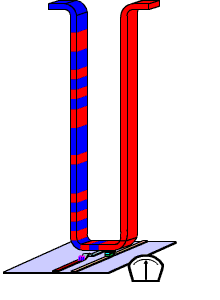Created the first sample track memory
 Researchers at IBM have created the first sample of the so-called “track” memory (racetrack memory), which has long been discussed as the most likely replacement of existing digital data storage technologies. Until now, the matter has not advanced further than theoretical studies, and now, finally, the first device has been created that is capable of recording and counting three bits of data.
Researchers at IBM have created the first sample of the so-called “track” memory (racetrack memory), which has long been discussed as the most likely replacement of existing digital data storage technologies. Until now, the matter has not advanced further than theoretical studies, and now, finally, the first device has been created that is capable of recording and counting three bits of data.Track memory consists of a magnetic U-shaped nanofiber and two magnetic heads for reading and writing data. Information is stored in domains that move through the nanofibers. High-capacity memory modules can be stamped from such U-structures. Similar principles of data storage were offered by engineers from the 1960s – 1970s of the last century, but only with the transition to the nano level it became possible to qualitatively improve performance.
Thanks to this technology, it becomes quite possible to create a cheap non-volatile memory, which will be orders of magnitude greater than the existing in density and speed of work. The idea of creating such a memory belongs to one of the leading researchers at IBM, Stuart Parkin, who patented it more than four years ago ( US Patent No. 6,834,005 ). Since then, Parkin has been developing in a specially equipped IBM laboratory ( photo ).
')
Source: https://habr.com/ru/post/23490/
All Articles